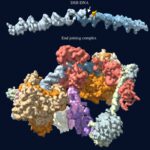Link to Pubmed [PMID] – 20151727
Link to HAL – Click here
Link to DOI – 10.1063/1.3298862
J Chem Phys 2010 Feb;132(6):064101
The Poisson-Boltzmann (PB) formalism is among the most popular approaches to modeling the solvation of molecules. It assumes a continuum model for water, leading to a dielectric permittivity that only depends on position in space. In contrast, the dipolar Poisson-Boltzmann-Langevin (DPBL) formalism represents the solvent as a collection of orientable dipoles with nonuniform concentration; this leads to a nonlinear permittivity function that depends both on the position and on the local electric field at that position. The differences in the assumptions underlying these two models lead to significant differences in the equations they generate. The PB equation is a second order, elliptic, nonlinear partial differential equation (PDE). Its response coefficients correspond to the dielectric permittivity and are therefore constant within each subdomain of the system considered (i.e., inside and outside of the molecules considered). While the DPBL equation is also a second order, elliptic, nonlinear PDE, its response coefficients are nonlinear functions of the electrostatic potential. Many solvers have been developed for the PB equation; to our knowledge, none of these can be directly applied to the DPBL equation. The methods they use may adapt to the difference; their implementations however are PBE specific. We adapted the PBE solver originally developed by Holst and Saied [J. Comput. Chem. 16, 337 (1995)] to the problem of solving the DPBL equation. This solver uses a truncated Newton method with a multigrid preconditioner. Numerical evidences suggest that it converges for the DPBL equation and that the convergence is superlinear. It is found however to be slow and greedy in memory requirement for problems commonly encountered in computational biology and computational chemistry. To circumvent these problems, we propose two variants, a quasi-Newton solver based on a simplified, inexact Jacobian and an iterative self-consistent solver that is based directly on the PBE solver. While both methods are not guaranteed to converge, numerical evidences suggest that they do and that their convergence is also superlinear. Both variants are significantly faster than the solver based on the exact Jacobian, with a much smaller memory footprint. All three methods have been implemented in a new code named AQUASOL, which is freely available.

